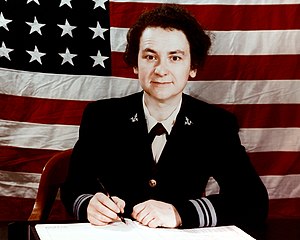We've got 15 definitions for WAVES »
What does WAVES stand for?
What does WAVES mean? This page is about the various possible meanings of the acronym, abbreviation, shorthand or slang term: WAVES.
| Term | Definition | Rating |
|---|---|---|
| WAVES | Women Accepted for Volunteer Emergency Service | |
| WAVES | Waveform And Vector Exchange Specification | |
| WAVES | Workers And Visitors Entrance System | |
| WAVES | With Added Value Enabled Services | |
| WAVES | Worldwide Address Verification and Enhancement System | |
| WAVES | Women Against Violence Education Service | |
| WAVES | Water, Atmosphere, Vegetation, Energy, and Solute | |
| WAVES | We All Value Exceptional Service | |
| WAVES | Wealth Accounting and the Valuation of Ecosystem Services | |
| WAVES | Wireless Audio Visual Emergency System | |
| WAVES | Women Accepted for Voluntary Emergency Service | |
| WAVES | We Are Very Enthusiastic Singers | |
| WAVES | Water Adventure Voluntourism Education And Sustainability | |
| WAVES | We Are Very Educators for Society | |
| WAVES | Women Accepted for Volunteer Emergency Services |
What does WAVES mean?
- WAVES
- The United States Naval Reserve (Women's Reserve), better known as the WAVES (for Women Accepted for Volunteer Emergency Service), was the women's branch of the United States Naval Reserve during World War II. It was established on July 21, 1942, by the U.S. Congress and signed into law by President Franklin D. Roosevelt on July 30. This authorized the U.S. Navy to accept women into the Naval Reserve as commissioned officers and at the enlisted level, effective for the duration of the war plus six months. The purpose of the law was to release officers and men for sea duty and replace them with women in shore establishments. Mildred H. McAfee, on leave as president of Wellesley College, became the first director of the WAVES. She was commissioned a lieutenant commander on August 3, 1942, and later promoted to commander and then to captain. The notion of women serving in the Navy was not widely supported in the Congress or by the Navy, even though some of the lawmakers and naval personnel did support the need for uniformed women during World War II. Public Law 689, allowing women to serve in the Navy, was due in large measure to the efforts of the Navy's Women's Advisory Council, Margaret Chung, and Eleanor Roosevelt, the First Lady of the United States. To be eligible for officer candidate school, women had to be aged 20 to 49 and possess a college degree or have two years of college and two years of equivalent professional or business experience. Volunteers at the enlisted level had to be aged 20 to 35 and possess a high school or a business diploma, or have equivalent experience. The WAVES were primarily white, but 72 African-American women eventually served. The Navy's training of most WAVE officer candidates took place at Smith College, Northampton, Massachusetts. Specialized training for officers was conducted on several college campuses and naval facilities. Most enlisted members received recruit training at Hunter College, in the Bronx, New York City. After recruit training, some women attended specialized training courses on college campuses and at naval facilities. The WAVES served at 900 stations in the United States. The territory of Hawaii was the only overseas station where their staff was assigned. Many female officers entered fields previously held by men, such as medicine and engineering. Enlisted women served in jobs from clerical to parachute riggers. Many women experienced workplace hostility from their male counterparts. The Navy's lack of clear-cut policies, early on, was the source of many of the difficulties. The WAVES' peak strength was 86,291 members. Upon demobilization of the officer and enlisted members, Secretary of the Navy James Forrestal, Fleet Admiral Ernest King, and Fleet Admiral Chester Nimitz all commended the WAVES for their contributions to the war effort.
Still can't find the acronym definition you were looking for? Use our Power Search technology to look for more unique definitions from across the web!
Citation
Use the citation options below to add these abbreviations to your bibliography.
Style:MLAChicagoAPA
"WAVES." Abbreviations.com. STANDS4 LLC, 2024. Web. 16 Apr. 2024. <https://www.abbreviations.com/WAVES>.



Discuss these WAVES abbreviations with the community:
Report Comment
We're doing our best to make sure our content is useful, accurate and safe.
If by any chance you spot an inappropriate comment while navigating through our website please use this form to let us know, and we'll take care of it shortly.
Attachment
You need to be logged in to favorite.
Log In